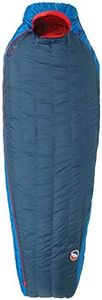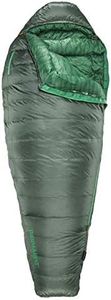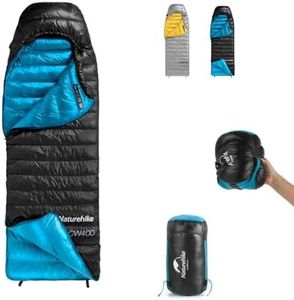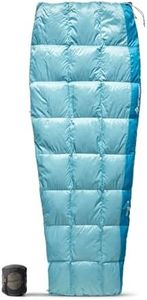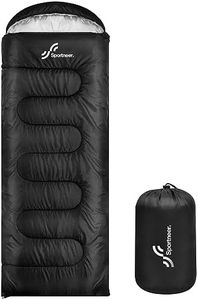We Use CookiesWe use cookies to enhance the security, performance,
functionality and for analytical and promotional activities. By continuing to browse this site you
are agreeing to our privacy policy
10 Best Backpacking Sleeping Bag
From leading brands and best sellers available on the web.By clicking on a link to a third party's website, log data is shared with that third party.
Buying Guide for the Best Backpacking Sleeping Bag
Choosing the right backpacking sleeping bag is essential for making sure you stay comfortable, warm, and safe during your outdoor adventures. The best sleeping bag for you depends not only on where and when you’ll be camping but also on how much you value weight, comfort, and durability. When shopping, focus on the main specs that determine how a sleeping bag performs so you can find a model that suits your needs and makes your outdoor experience more enjoyable.Temperature RatingThe temperature rating tells you the lowest temperature at which the sleeping bag will keep the average user warm. It’s important because it helps you match your sleeping bag to the coldest conditions you expect to encounter. Temperature ratings are typically grouped into summer (above 35°F/1.6°C), three-season (15-35°F/-9.4 to 1.6°C), and winter (below 15°F/-9.4°C). To choose the right rating, consider the typical nighttime temperatures in your camping area and pick a bag rated slightly lower than the expected lows to ensure you don’t get cold.
Insulation TypeSleeping bags are typically filled with either down or synthetic insulation. Down is very lightweight, compressible, and warm, making it ideal for weight-conscious backpackers, but it can lose its insulating power when wet. Synthetic insulation tends to be heavier and bulkier, but it retains warmth even if damp and usually costs less. If you often hike in dry, cold weather, down is a great choice; for wet climates or if you want easier care, synthetic may be better for you.
Bag ShapeSleeping bags come in several shapes, mainly mummy, rectangular, and semi-rectangular. Mummy bags are snug and efficient at keeping you warm since they reduce air space, making them great for cold conditions and lighter to carry. Rectangular bags give more room to move and are better for comfort in mild weather but don’t keep heat in as well. Semi-rectangular bags are a compromise. Think about how much you move when you sleep, your need for warmth, and whether pack space is at a premium when deciding.
WeightThe weight of the sleeping bag matters most for backpackers who need to carry their gear. Lightweight bags (usually under 2 pounds/900 grams) are ideal for long distances but may be less comfortable or durable. Moderate-weight bags (2–4 pounds/900 grams–1.8 kg) balance comfort and packability, while heavier bags are usually only suitable for car camping. Choose the lightest bag that still meets your warmth and comfort needs for the trips you take.
Pack SizePack size refers to how small you can compress your sleeping bag for transport, which is important if you have limited pack space. Down bags usually compress tighter than synthetic ones. Smaller pack sizes are best for those with smaller backpacks or when you want to save space for other gear. Make sure the packed size fits well with the rest of your equipment in your backpack.
Shell MaterialThe shell material is the outer fabric of the sleeping bag, and it affects both durability and water resistance. Tougher shells resist tears and abrasions, while water-resistant treatments help keep your insulation dry from dew or condensation. Look for materials that balance weight and strength, and prioritize tougher shells if you camp in rugged areas or want the bag to last longer.

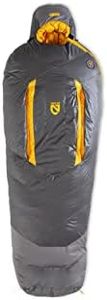

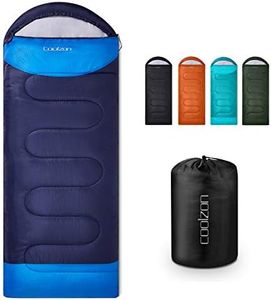
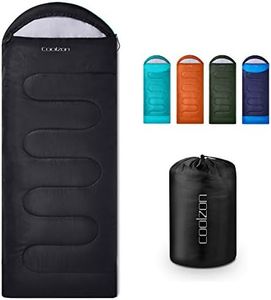

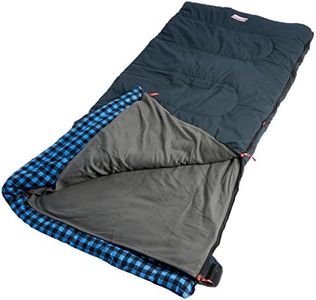
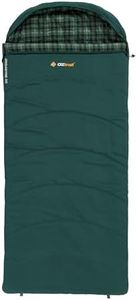
![QEZER Ultralight Down Sleeping Bag [ 2°C~8°C,1180g] All Season Adult or Kid Sleeping Bag for Camping, Backpacking, Hiking,and Traveling, Envelope Lightweight and Portable (Black)](https://images-proxy.bestreviews.guide/rG2q3QOT2dTR7qNlB40beEZ_cIM=/0x300/https://m.media-amazon.com/images/I/41ZBwKUA1rL._AC_CX679_.jpg)
